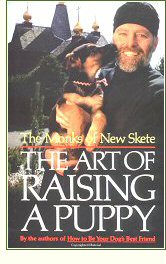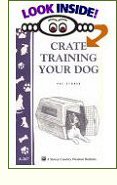Recommended Books
 The Art of Raising a Puppy
The Art of Raising a Puppy
By The Monks of New Skete
The monks of New Skete have been breeding and training dogs at their New York monastery for more than 20 years. Their philosophy of raising dogs accentuates the essential human-canine bond, whereby owners must learn to understand a dog's instincts, needs, and behavior. Understanding a dog, the monks say, is the key to successfully training him. They first published this philosophy in their 1978 classic guide How to Be Your Dog's Best Friend. Now the monks concentrate on the first three months of a puppy's life in The Art of Raising a Puppy.
The book observes a litter of monastery puppies from birth to 12 weeks. Tender photographs and dialogue reflect these precious first few weeks of life. Even at this time, the human-canine link is vital; the monks stress the importance of gentle touch to help forge this connection. Basic puppy training techniques are explored and executed, all of which puppy owners should find easy to implement. Virtually all types of dog problems and dog training are examined in the book, always in compassionate and easily comprehensible language. The monks also look well beyond surface training techniques to analyze the roots of dogs' problems and explain how training can help. Owners are taught how to gently assert dominance over their dog, which will make for a long-lasting and fulfilling relationship. Beautiful black-and-white photographs of monastery puppies will pull at every heartstring.
From Publishers Weekly
The monks of New Skete in Cambridge, New York, dog trainers and breeders of German shepherds, here expand on their classic How to Be Your Dog's Best Friend . The excellent instruction begins with an in-depth examination of the puppies of one litter from birth through their eventual placements with new owners-- following their social and physical development, their needs, and clues to their emerging personalities. Proposing that the best way to forge a healthy dog-to-owner bond is to prevent problems before they occur, the authors soundly emphasize that a puppy begins its training "the day it arrives home." They teach readers how to choose an appropriate breed and a promising puppy, and how to assume the position of "pack" leader from the start. Sensitive and unimpeachably humane, this handbook places equal stress on the time-consuming responsibilities of dog ownership and on its ultimate rewards. Photos.
From Library Journal
The monks, who have bred and trained dogs and counseled owners for 20 years, believe that most puppies, if treated "carefully and intelligently," will grow into happy, adult companions. In their guide to raising puppies, they discuss growth phases, critical periods, and feral instincts. Emphasis is on preventing problems before they arise. The monks show how to recognize various temperaments, and how to care for and train the puppies properly. Libraries that already have Carol Benjamin's Mother Knows Best (Howell, 1989) or Charlotte Schwartz's The Howell Book of Puppy Raising (Howell, 1987) could forgo this. However, the popularity of the monks' first book, How To Be Your Dog's Best Friend (LJ 9/15/78), may create a demand for their second. -Helen Sondrol, Lincoln Univ. Lib., Pa.
 Good Owners, Great Dogs
Good Owners, Great Dogs
By S. Bryan/Wilson Kilcommons
Ingram
A student of the renowned British trainer, Barbara Woodhouse, reveals the secrets of lifetime behavioral dog training techniques and provides information on everything from canine dietary needs to temperament testing. 50,000 first printing.
I truly believe that it's a sin to get a dog and not give it any obedience training. Dogs are of a pack nature and someone must always be the leader of the pack. If you aren't designated, they will designate themselves. Dogs need to know who's in charge. They're happier that way when they know their boundaries and what they can and cannot do. They become true friends, yet with you being the friend in charge. This book is very informative. Brian Kilcommons was taught by Barbara Woodhouse. One of the greatest dog trainers of all times. He shows you how to teach you dog obedience in a very firm, yet sensible, humane,(no hitting)way, yet not a"namby pamby" and ineffective way, that I've seen with some other dog training programs. We brought home a big untrained dog from the SPCA who, while we were away for the day, literally ripped our home to pieces. He wouldn't do one thing we told him and I thought we had made a big mistake with this HUGE dog and would never be able to control him. I wanted to bring him back.
My daughter suggested this book. Within ONE WEEK this dog was doing almost everything we told him to and he was happy doing it! He never touches ANYTHING of ours now. He waits politely at the door when he wants to go out. He used to knock me over trying to be the first one to reach the door. He won't cross the threshold of the open door unless you say it's okay. (Comes in handy if the police ever show up at your door), because they will shoot any dog that runs at them in play or in aggressive). He used to run all over the house to avoid a bath, tearing it up in the process. Now, when I say 'It's bath time he walks down the hall, into the bathroom and climbs into the tub, all by himself! He used to snatch his dog toys out of our hand biting us accidently in the process. Now, he waits nicely and sits and when you do hand him the ball, he takes it ever so carefully by the side of his teeth so he won't accidently bite us. The list goes on and on.
Some people teach their dogs the nasty habits and aggressivenenss and maybe don't realize that THEY are the ones responsible for the dog bad behavior. Brian Kilcommons explans this and shows you how to correct it. Even older dogs have broken bad habits with his program. You can see he truly loves dogs. They are his life and his book and video is a joy to have. My niece has a Great Dane who is a horror. She's even been to obedience school, but, they don't enforce any of the training at home. The dog is the boss of the house and knows it. She does what she wants and she's NOT a joy for their family to be around and they admit it. We wouldn't trade our dog now for a million bucks. I have recommended this book to them. I also have the video with the same title. With both book and video them in hand and the firm resolve to stick with it, there is no reason why anyone should have a dog that is a "holy terror".
Reviewer: A reader
I'm a Veterinary Technician, thus get many questions about puppy training and see a number of behavioral "problems waiting to happen". Brian's book and The Art of Raising a Puppy by The Monks of New Skete are the top two books I recommend owners to read. Both books are quick reads -- filled with easy-to-apply positive reinforcement training techniques and give the "whys" behind the behavior.
I've seen Brian in action -- he's a high-energy trainer and an entertaining speaker. Within two minutes, he had a 6-month old puppy he'd never seen before following him on leash, watching his every move, and obeying commands in a heartbeat, all done with positive reinforcement. This dog barely followed his owner and would not obey commands until told 3-4 times. I walked away from his seminar with a lot of practical information I could reapply at the vet clinic and at home. --This text refers to an out of print or unavailable edition of this title.
How to Housebreak Your Dog in 7 Days
By Shirlee Kalstone
Reviewer: A reader from Hoboken, NJ USA
This is a great book!! My puppy was trained within a week and I give credit to this book. It lays down a great plan of action. Just follow the book and you will be much happier with your dog.
 Crate Training Your Dog
Crate Training Your Dog
Storey Country Wisdom Bulletin A-267
Reviewer: A reader from Portland, OR
Crate training works because dogs, like their wild ancestors, desire a snug "den" that affords security and privacy. When dogs are crate trained properly, they accept and even enjoy their sequestered time. The author, Pat Storer, is a dog breeder, a show judge, a specialist in dog temperament, and the author of eight animal-care books.
Storer shows you how to maintain a positive, loving attitude while being firm and consistent with your dog. With Storer's advice on choosing the right crate, step-by-step instructions, and tips for dealing with crate-related behavior problems, both you and your dog will find crate training to be a simple, successful experience.
![]()










